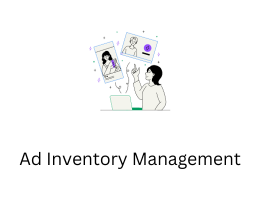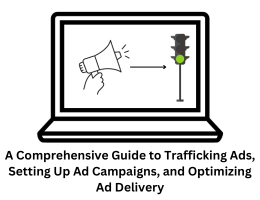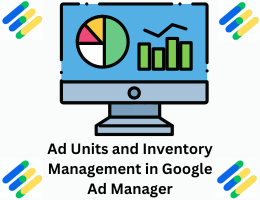
Ad Inventory Management
- By admin --
- Thursday, 26 Oct, 2023
Ad Inventory Management: Optimizing Digital Advertising Space
Ad inventory management is a crucial component of digital advertising, helping publishers maximize their revenue potential while offering advertisers effective placement opportunities. In this article, we'll delve into the concept of ad inventory, its importance, and the strategies used to manage it effectively.
What is Ad Inventory?
Ad inventory refers to the available advertising space on a publisher's website or application. This space can include banner ads, video ads, native ads, and other ad formats. Advertisers purchase this space to display their advertisements to the publisher's audience. Ad inventory can be categorized into two primary types:
-
Direct-Sold Inventory: This is ad space that publishers sell directly to advertisers through traditional sales methods. It often involves custom, high-impact ad units and premium placements.
-
Programmatic Inventory: This includes ad space that is sold through automated processes, such as real-time bidding (RTB) or private marketplaces. Programmatic inventory can be sold to multiple advertisers simultaneously and often includes standard ad units.
The Importance of Ad Inventory Management
Efficient ad inventory management is vital for both publishers and advertisers:
For Publishers:
-
Maximizing Revenue: Publishers can optimize their ad inventory to ensure they are selling their available space at the highest possible rates. This is critical for sustaining their online businesses.
-
User Experience: Effective ad inventory management ensures that ads are not intrusive and do not compromise the user experience on a website or app. This helps in retaining and growing the audience.
-
Data-Driven Insights: Managing ad inventory provides valuable data on ad performance, audience engagement, and revenue generation. This data can inform strategic decisions.
For Advertisers:
-
Targeted Placements: Advertisers can identify the right inventory that matches their target audience, which increases the relevance of their ads and improves campaign effectiveness.
-
Cost Efficiency: Proper inventory management enables advertisers to control their ad spend more effectively, ensuring they allocate budgets to the most valuable placements.
-
Ad Quality: Advertisers can assess ad inventory to ensure that their brand is associated with high-quality content, enhancing brand safety.
Strategies for Effective Ad Inventory Management
Effective ad inventory management involves a combination of strategies to ensure optimal utilization. Here are some key strategies:
-
Ad Slot Optimization: Publishers need to determine the best locations for ad placements on their websites or apps. This includes considerations for ad format, size, and placement to maximize user engagement and revenue.
-
Ad Unit Diversification: Offering a variety of ad formats such as display ads, video ads, native ads, and more can attract a broader range of advertisers and increase revenue potential.
-
Pricing Strategies: Publishers can implement dynamic pricing strategies, adjusting rates based on factors like ad position, audience demographics, and the time of day.
-
Ad Blocker Mitigation: Ad blockers can significantly impact revenue. Publishers can use anti-ad-blocking solutions to maintain ad visibility for their audience.
-
Real-Time Bidding (RTB): Integrating RTB into your ad inventory management allows for programmatic selling, which can lead to increased competition and potentially higher rates for your ad space.
-
Audience Segmentation: Tailor ad inventory offerings to specific audience segments, allowing for more targeted advertising opportunities and potentially higher CPMs.
-
Ad Refreshing: Implementing ad refreshing strategies can show multiple ads in the same placement, increasing ad impressions and potential earnings. However, it should be done in a way that doesn't disrupt the user experience.
-
Private Marketplaces: Publishers can create private marketplaces for premium advertisers, offering exclusive access to specific ad inventory at premium rates.
-
Ad Inventory Forecasting: Use data and analytics to predict future ad inventory availability, allowing for more accurate pricing and planning for both publishers and advertisers.
-
Ad Quality Control: Monitor the quality and relevance of ads displayed on your inventory to ensure brand safety and maintain a positive user experience.
-
A/B Testing: Experiment with different ad formats, placements, and pricing strategies to determine what works best for your specific audience and niche.
-
Data Analysis: Regularly analyze data and performance metrics to identify trends and adjust your inventory management strategies accordingly.
Challenges in Ad Inventory Management
While ad inventory management offers significant benefits, it comes with its own set of challenges:
-
Ad Blocking: The rise of ad blockers has impacted ad inventory visibility and revenue. Publishers need to implement strategies to combat ad blocking.
-
Ad Fraud: Ad inventory can be affected by ad fraud, which involves illegitimate clicks, impressions, or conversions. Effective fraud prevention measures are essential.
-
User Experience: Balancing the need for revenue with a positive user experience is a constant challenge. Intrusive ads can lead to audience dissatisfaction.
-
Data Privacy and Regulation: Compliance with data privacy laws, such as GDPR and CCPA, adds complexity to ad inventory management.
-
Competition: With many publishers vying for advertisers' attention, competition for ad inventory can be fierce. Publishers need to differentiate themselves to attract quality advertisers.
Conclusion
Ad inventory management is a critical aspect of the digital advertising ecosystem, enabling publishers to monetize their online spaces effectively while providing advertisers with the opportunity to reach their target audiences. By implementing the right strategies and overcoming challenges, publishers and advertisers can create a win-win scenario where user experience is preserved, and revenue potential is maximized.





